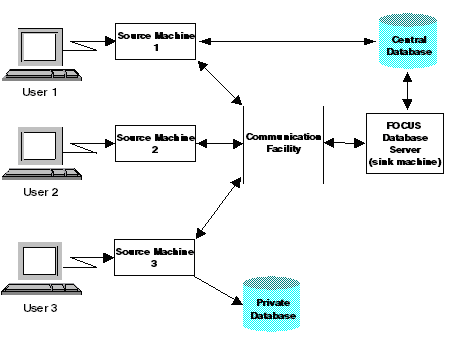
Multiple users can read and change a FOCUS or XFOCUS database at the same time, using FOCUS and/or Host Language Interface (HLI) commands, through the Simultaneous Usage (SU) facility. Without SU, only one user can update a database at a time, even databases that are allocated for sharing (DISP=SHR).
With SU, a centrally controlled database is allocated to a background job called the FOCUS Database Server or sink machine. TSO IDs, MSO sessions, and batch jobs running FOCUS, as well as programs using HLI, that send database retrieval and update requests to the FOCUS Database Server are all called source machines or clients. Source machines send requests and transactions to the FOCUS Database Server, which processes their transactions and transmits retrieved data and messages back to the source machines.
In the remainder of this manual, the terms FOCUS Database Server, server, and sink machine will be used interchangeably as will the terms source machine and client.
The following representation of SU shows three source machines (a TSO user, a batch job, and an HLI application) executing FOCUS requests. Source machines communicate with the FOCUS Database Server through cross-memory posting. Messages traveling between a source machine and the FOCUS Database Server are placed in the z/OS Common Storage Area (CSA), which is accessible to both machines. When the FOCUS Database Server receives a request from a source machine, it changes or retrieves data from the centrally controlled database and transmits the results back to the source machine. Notice that User 3 on the diagram is also working on a locally controlled database (not managed by SU).

SU is not needed when users are simply reading a database (for example, issuing TABLE requests), but it is needed when they want to change databases that others are reading.
Only those changing databases need SU. The Multi-Threaded SU Reporting Facility permits multiple users to read centrally controlled databases without a FOCUS Database Server. The Multi-Threaded SU Reporting Facility is described in The Multi-Threaded SU Reporting Facility.
Note the following:
| Information Builders |